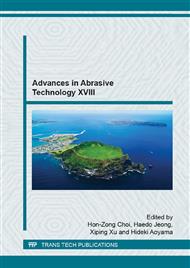p.293
p.299
p.305
p.311
p.317
p.321
p.327
p.333
p.338
Study on Removal Mechanism of Sapphire in Plasma Assisted Polishing
Abstract:
A sapphire substrate is essential for epitaxial growth of GaN, which is used for high brightness light-emitting diodes (LEDs), high-power and high-frequency devices. However, the material removal rate (MRR) of sapphire in conventional polishing is very low because of its high hardness and chemical inertness. We proposed application of plasma assisted polishing using a resin-bonded silica grinding stone for finishing of sapphire surface and investigated basic removal properties. The results of a ball-on-disc type test results showed that irradiation of water vapor containing atmospheric pressure Ar gas plasma promoted the MRR of sapphire by a factor of 7.4. Strong emission from hydroxyl radical was observed by an optical emission spectroscopy measurement of the plasma. XPS measurements revealed that the surface of both sapphire and silica were hydroxylated after the plasma irradiation. From these experimental and measurement results, we proposed the removal model in plasma assisted polishing of sapphire as follows. Firstly, irradiation of water vapor plasma hydroxylates the surfaces of sapphire and silica. Then, Al-O-Si bonding is formed by dehydration reaction between sapphire and silica surfaces. Finally, surface atom of sapphire is removed by the motion of silica abrasive. In this paper, we describe the preliminary experimental results and measurement results which support the proposed removal model in plasma assisted polishing of sapphire.
Info:
Periodical:
Pages:
317-320
Citation:
Online since:
January 2016
Authors:
Price:
Сopyright:
© 2016 Trans Tech Publications Ltd. All Rights Reserved
Share:
Citation:


